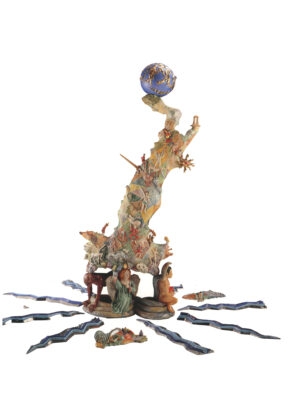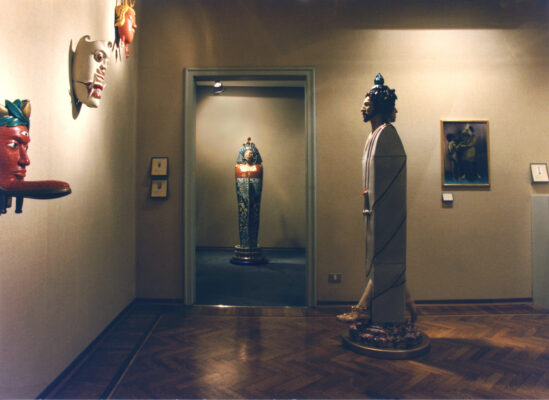Home / Exhibitions / Luigi Ontani, Idea Aida del Vero Diffida
Luigi Ontani. Idea Aida del Vero Diffida
curated by Renato Barilli
09.12.1995 — 10.02.1996
Luigi Ontani
Idea Aida del Vero Diffida
curated by Renato Barilli
09.12.1995 - 10.02.1996Show introduction
The exhibition dedicated to Luigi Ontani in Verona at Galleria dello Scudo from December 10, 1995, a few months after his solo room in the Italian pavilion of the Venice Biennale, gathered together more than fifty works from public and private collections, highlighting how the artist’s language represented a kind of metamorphosis of the classical, regenerated into a paradoxical rhetoric of modernity.
The aim of the show, realized under the patronage of the Municipality Department of Culture, City of Verona, was to confirm the standing of Ontani in the 1980s, after his beginnings in the context of the Arte Povera/Conceptual climate of the preceding decade, though he experienced it with the ambiguities of play that already characterised his art, from the object that became a work of art to behavioural actions. The works selected documented the development of an experience that, with the play of irony and of anachronism, attempted to close the distance between history and real time by the use of the most varied techniques, from a photography that is gratifying because of its refusal of black and white, to diaphanous and immaterial watercolour, and the Mannerist palette of certain oils on canvas and the chromatic splendour of glass and ceramic.
The show opened with Autoritratto nudo d'après Chirico, a tableau vivant dating from 1978 which emblematically reassumed earlier quotations and anticipates the refined series of images stimulated by journeys to the East, these too shot through with the hedonistic narcissism that had become capable of any kind of modification. Dating from 1982 are such brilliantly coloured masks as Sayang, a look at the Indian and Balinese cultures of which Goffredo Parise has also written.
The return to painting that at the time was an audacious inversion of trends, was represented by two large-size watercolours: the triptych Grillo Dante Ridondante in Inferno/Purgatorio/Paradiso, 1983, and the composition with Orfeo e Euridice conceived of in 1984 for the large exhibition Der Traum des Orpheus, held in Munich. There were then the oils on canvas the allegory of Endimione e Demonio, shown at the solo show at the Galleria dell’Oca in 1986, and Palazzo degli Ontani, 1988, an example of a perfect symbiosis between a strange mise-en-scène and a precious artisanal object.
Referred back to the 1990s are Vanità in età and Indiarosa, retouched photos in which the artist had once again represented himself as Narcissus. In the section devoted to ceramics the sumptuous shape of Panontale (1993) were proposed, next to the four Ermestetiche and to Tribù tabù created for the Venice Biennale. The title of the show was inspired by the plastic and multicoloured metamorphosis of Aida that closes the show.
The exhibition, designed by Massimo Di Carlo, Francesco Sandroni, and Massimo Simonetti, was curated by Renato Barilli. The catalogue, published for this occasion, has a fundamental contribution by Renato Barilli, essays by Gabriella Belli and Manlio Brusatin, a literary-magical tale by Gian Piero Bona, and critical thoughts by Corrado Levi. The volume is rounded off by a wide-ranging biography written by Laura Lorenzoni, as well as an ample section of references.










